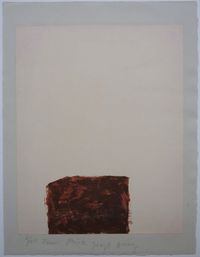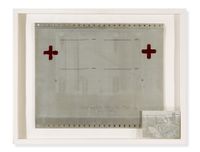German artist Joseph Beuys is both a widely celebrated and contested artist who coined the term 'social sculpture'. To many, Beuys is an enigma with an elaborate mythos that coloured his work throughout his lifetime.
Read MoreBeuys was born in Krefeld, Germany. He grew up in Kleve, an industrial town close to the Dutch border, and was a member of the Hitler Youth. During World War II, Beuys was drafted into the air force and served throughout the war. In 1944, his aircraft crashed into the Crimea. After the German surrender, Beuys was sent to a British internment camp for three months until finally returning to Kleve.
Beuys studied sculpture at the Staatliche Kunstakademie in Düsseldorf from 1947 to 1951 and later received his Master's degree in 1953. During his studies, Beuys founded the Donnerstag-Gesellschaft (Thursday Group) alongside other German artists Hann Trier and Eugen Batz. The group organised discussions, exhibitions, and concerts. In 1961, Beuys was appointed as a professor of sculpture at the Staatliche Kunstakademie in Düsseldorf.
Beuys became politically active in the 1960s, often integrating his activist practices with his artistic interventions. He was involved in establishing the German Student Party in 1967, as well as the Green Party with German politician Joschka Fischer. At around the same time, Beuys became associated with the international Fluxus movement and was a key figure in their performances and happenings. Through his political involvement, Beuys envisioned his work as 'social sculptures', which embraced art's capacity to invoke social change.
Beuys is a highly contested and eccentric figure in art history. His work and legacy are influenced by his own personal mythmaking, storytelling, and shamanism, coloured by his involvement during the war and after.
Formative to his artistic practice was the myth Joseph Beuys fashioned for himself about his experiences during the war. When his plane was shot down in 1944, Beuys claimed that he was rescued by nomadic Tatars, who wrapped his body in fat and felt as insulation. While this story has been proven false, Beuys had used this narrative as a basis for his artwork and the extensive use of fat and felt as meaningful material in his work.
An example of a work that uses these materials is Fat Battery (1963), in which Beuys imitates the form of a battery with these two materials to reflect his concern with energy and how it is stored. Another work with these motifs is Fat Chair (1964), where a triangular slab of fat sits on an old chair with a wire sticking out through its top.
Apart from sculptural work, Beuys is also known for his performances, which he referred to as 'actions'. Through these events, he encouraged viewers to adapt the political and social messages found throughout his work into their daily lives. While Beuys saw himself as a performer, he also expanded the field of performance by creating environments that would be activated through these 'actions'.
Beuys' 'actions' often involved objects such as fat, felt, coal, and wood alongside ritualistic gestures that criticised the values championed by the West. One of his first performances was How to Explain Pictures to a Dead Hare (1965). In this performance, he locked the doors to the gallery, forcing viewers to watch through its windows as he talked to a dead hare in his hands with honey and gold leaf on his face. After three hours, viewers were allowed into the space while Beuys stood still in the gallery with the hare.
Another work, entitled I Like America and America Likes Me (1974) involved Beuys, wrapped in felt, arriving at René Block Gallery in New York in an ambulance to meet with a coyote. For three days, Beuys shared the solitary space with the wild animal, staging himself as a spiritual leader between the U.S. and Native American cultures.
Beuys coined the term 'social sculpture' as an expanded definition of art that encompasses the everyday. In this definition, society at large is considered to be a work of art, and everybody is able to contribute to its development. Beuys believed that everyone, regardless of work or social class, can contribute to society through creative reimagining and positive social change.
Beuys' famous social sculpture 7000 Oaks (1982) was conceptualised for documenta 7. Along with volunteers, Beuys planted 7,000 oak trees across Kassel, Germany in an effort to reforest and repopulate the war-damaged city.
Joseph Beuys was a productive artist during his lifetime. His works have been exhibited posthumously around the world, including at the Dia Center for the Arts, New York; Gropius-Bau, Berlin; Museum of Modern Art, New York; and Centre Pompidou, Paris. The artist's work has been collected by numerous international institutions across the globe, including by the Centre Pompidou; National Gallery of Victoria, Melbourne; Germanisches National Museum, Nürnberg; National Museum of Modern and Contemporary Art, Seoul; Tate, London; and The Broad, Los Angeles.
Arianna Mercado | Ocula | 2022











